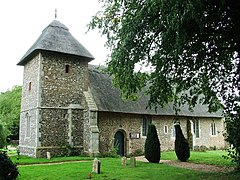Thornham Parva
| Thornham Parva | |
|---|---|
 Church of St Mary |
|
| Thornham Parva shown within Suffolk | |
| Population | 50 |
| District | |
| Shire county | |
| Region | |
| Country | England |
| Sovereign state | United Kingdom |
| Post town | Eye |
| Postcode district | IP23 |
| Police | Suffolk |
| Fire | Suffolk |
| Ambulance | East of England |
| EU Parliament | East of England |
Thornham Parva is a village and civil parish in the Mid Suffolk district of Suffolk in eastern England. Located to the north of sister village Thornham Magna and around five miles south of Diss, in 2005 its population was 50. By the time of the 2011 Census population's of less than 100 were not maintained separately and this village was included in the population of Thornham Magna.
The tiny thatched Saxon church of St Mary's has early 14th century wall paintings, on the south wall, the early years of Christ and on the north wall, the martyrdom of St Edmund. There is a circular Saxon window as well as the famous retable. Architect Basil Spence died in 1976 at his home at Yaxley, Suffolk and was buried at Thornham Parva.
The Thornham Parva Retable is a 15 feet (4.6 m) long medieval altarpiece, thought to have been created in the 1330s for a Dominican Priory. It is the largest surviving altarpiece from the English Middle Ages. It survived the reformers of the 16th Century, who raged against idolatry and destroyed most of England's medieval culture, by being stored in a barn. It was thought worth saving for future building material. It was discovered in 1927 in a wood pile in a loft belonging to the local landowner, Lord Henniker. He donated it to the church of Thornham Parva where his brother was parson.
The origins of the retable were a puzzle but the picture itself provided vital clues. The figures pinpointed links with the Dominican Order. At either end are St Dominic and St Peter Martyr, joint patrons of the Dominicans. St Catherine and St Margaret of Antioch were the order's mascots. The Apostles Peter and Paul, who were believed to have spoken to St Dominic, all point towards Dominican interest. The presence of St Edmund means an East Anglian link. John the Baptist's figure might seem more obscure, but medieval donors demanded value for their money and the benefactors of the Dominican Priory at Thetford, John de Warenne, 7th Earl of Surrey and Edmund Gonville would have expected their namesakes to be part of the finished painting.
...
Wikipedia

